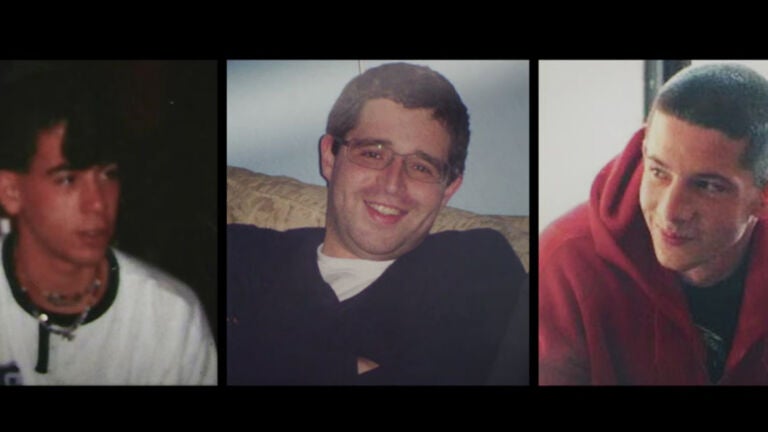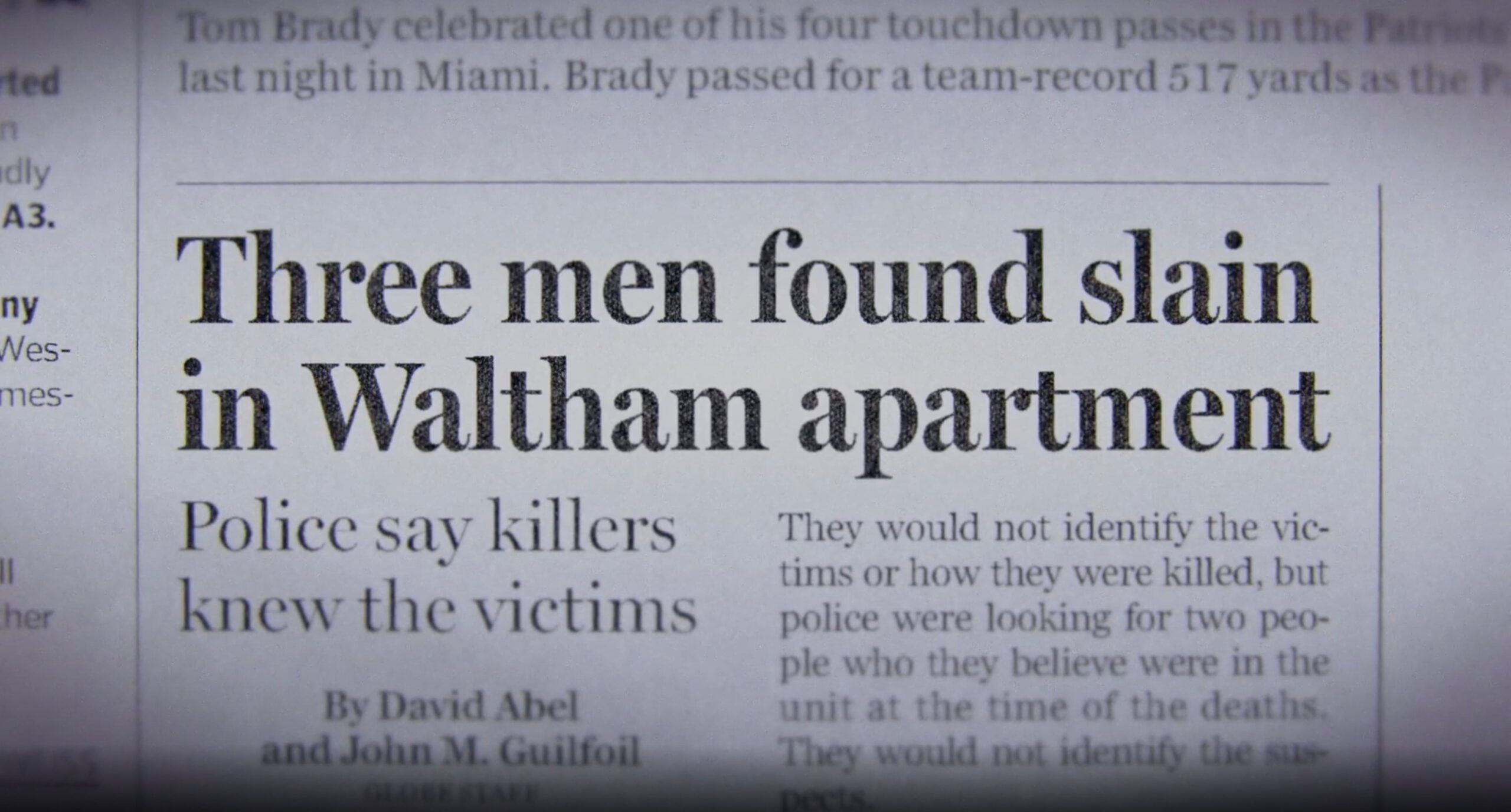Newsletter Signup
Stay up to date on all the latest news from Boston.com

On Sept. 11, 2011 — the 10-year anniversary of the 9/11 attacks — the city of Waltham was shaken by a triple homicide.
Authorities found Waltham residents Erik Weissman, Brendan Mess, and Rafi Teken dead. All three of the men’s throats were violently slashed, and a Waltham investigator called the crime scene “the worst bloodbath” he had ever seen, comparing the carnage to “an Al-Qaeda training video.”
When the Waltham Police Department canvassed for leads, friends and family of the victims repeatedly provided a name: Future Boston Marathon bomber Tamerlan Tsarnaev.
The 2011 triple homicide was the subject of “The Murders Before the Marathon,” a 2022 Hulu docuseries that was created, written, and produced by — and prominently featured — Susan Zalkind, a Boston-based investigative journalist.
Zalkind, who was friends with Weissman, has been investigating the triple homicide for close to 12 years. She wrote an in-depth story about the case for Boston magazine in 2014, followed by an appearance on “This American Life.” She appeared on MSNBC to discuss the case with Rachel Maddow and, in the years leading up to the Hulu documentary, penned additional pieces about it for outlets like The Daily Beast.
Zalkind’s new book, “The Waltham Murders: One Woman’s Pursuit to Expose the Truth Behind a Murder and a National Tragedy,” sums up all of her work. It asserts her unshakable conclusion that Tsarnaev and his friend, Ibragim Todashev, were responsible for the slayings. It also lays out, in painstaking detail, the myriad reasons why investigators have failed to close the case.
Billed as a “neo-noir Nancy Drew,” the book details what Zalkind calls “systemic rot” in the various government entities investigating the incident at the town, state, and federal levels. Using sources, public documents, and audio recordings, Zalkind shines a light on questionable conduct by members of the Waltham Police Department and criticizes “outrageous” inaction from the Middlesex DA’s office.
“Big picture, I think what the book shows is that there has been no process of accountability and review regarding those in charge — the Middlesex district attorney and the FBI — that would be indicative of a healthy democracy,” Zalkind said in an interview with Boston.com.

Shortly after Weissman, Mess, and Teken were killed, multiple people close to the victims told Waltham police they should question Tsarnaev. The future Marathon bomber trained at the same gym as Mess and could often be seen hanging out with the trio at Mess’s apartment.
Friends reported a change in Tsarnaev’s behavior leading up to the slayings, in which he became distant and voiced strong anti-American sentiments. Tsarnaev was also conspicuously absent from Mess’s funeral, and according to John Allan, the owner of the gym where Mess and Tsarnaev bonded, Tsarnaev laughed off Mess’s death when Allan asked him about it.
According to The New York Times, the Middlesex DA’s office did not question Tsarnaev at the time, even though his name was given to them by Waltham police.
Within days of authorities naming Tamerlan and Dzhokhar Tsarnaev as the Boston Marathon bombers, reports surfaced in The Boston Globe and other outlets that the Middlesex DA’s office was re-examining the Waltham triple homicide and how it might be tied to Tamerlan.
At the time, Middlesex DA Marian Ryan defended her office from questions about the pace and vigor of the Waltham investigation — and whether a more thorough investigation might have resulted in Tsarnaev’s arrest. (Ryan was appointed Middlesex DA in April 2013 after her predecessor, Gerard Leone Jr., resigned.)
“While we can not discuss details pertaining to the investigation — including evidence, suspects or witnesses — this office and its law enforcement partners have conducted a thorough, far-reaching investigation beginning in 2011 when this horrific crime occurred,’’ Ryan said in a statement. “This investigation has not concluded and is by no means closed.”
When questioned about new reporting in Zalkind’s book this year, Ryan issued a refrain that has been oft-repeated by her office when asked about the investigation, calling it “open and active.”
“People would love to know where you are as you’re moving through,” Ryan told Commonwealth Beacon’s Gintautas Dumcius. “That’s not how you move through an investigation to get to a good conclusion.”
Ryan’s office did not respond to a request for comment this week.

On May 22, 2013, a little more than a month after the Marathon bombing, Todashev, a friend of Tsarnaev, was shot to death by an FBI agent in his Orlando apartment, in what was later ruled to be self-defense.
This occurred after hours of interrogation and shortly after Todashev made a confession to his and Tsarnaev’s involvement in the Waltham triple murder.
Zalkind found that the FBI had asked many friends, acquaintances, and close associates of Todashev and Tsarnaev about the Waltham murders. According to Todashev’s wife (who had previously separated from Todashev), the FBI told her they had hard evidence that tied Todashev to the killings.
According to Zalkind, Todashev’s death has led to conspiracy theories circulating online, which she argues could have been minimized with greater transparency.
One popular theory as to why there has been a lack of transparency around the case is that tying Tamerlan Tsarnaev to the Waltham slayings would have weakened the U.S. government’s argument in front of the Supreme Court to reinstate the death penalty for Dzhokhar Tsarnaev.
Dzhokhar was initially sentenced to death in 2015, but a panel of appeals judges in 2020 vacated the death penalty, ruling that the judge in his original trial had, among other issues, precluded his defense attorneys from presenting evidence about the 2011 Waltham murders.
In October 2021, the Supreme Court ruled 6-3 to reinstate the death penalty. During oral arguments, Deputy Solicitor General Eric J. Feigin successfully argued that evidence potentially tying Tamerlan Tsarnaev to the Waltham triple homicide should not be considered.
“The only people who might have known what happened in Waltham were Todashev, who admitted to some participation, and possibly Tamerlan, and both of them are dead,” Feigin said.
Zalkind disagreed.
“The government is wrong,” she writes in chapter 38 of “The Waltham Murders.” “Tamerlan Tsarnaev and Ibragim Todashev did it. They killed those three men in Waltham. The basic facts of what happened are not ‘unknowable.’ The evidence of their guilt is readily available for anyone invested in seeking it.”

When Feigin said that Todashev and Tsarnaev were the only people who knew what happened in Waltham that night in September 2011, he may have been wrong in more ways than one.
Despite Feigin arguing before the Supreme Court in October 2021 that the truth of what happened in Waltham died with Todashev, the Middlesex DA’s office, in an open records request filed by Zalkind, said otherwise.
In her book, Zalkind writes that the Middlesex DA’s office confirmed that as recently as November 2021, they had “identified new potential sources of physical evidence,” and as recently as November 2020, they had interviewed a “material witness” in the case. As Zalkind notes, this was also the first time the Middlesex DA addressed Tsarnaev and Todashev by name, noting that they were “persons of interest” in the case who had since died.
While the DA’s office has made no indication of who that witness may be, Zalkind puts forth a compelling case in “The Waltham Murders” that Brendan Mess’s then-girlfriend, Hibatalla K. Eltilib, is someone authorities should consider interviewing further, if they haven’t already.
“Hiba,” as she was known to friends, was the person who discovered the three bodies in Waltham on the morning of Sept. 12, 2011.
Not long after the murders, she left the Boston area, eventually relocating to her native Sudan. (Zalkind writes in her book that Eltilib currently lives in Saudi Arabia.)
Following the Marathon bombing, friends and loved ones of Mess, Teken, and Weissman began discussing Eltilib and her friendship with Tsarnaev, or “Tam.”
“She and Tam got really close and became friends,’’ a friend of the group told The Boston Globe. “This was closer to Brendan’s death. They would share stories of their distaste for American culture. She was extremely aggressive and violent and had this radical way of thinking.’’
Eltilib defended herself in interviews with Zalkind, contending that those who suggested she was involved in the murders were racist.
But in “The Waltham Murders,” Zalkind unearthed information about Eltilib that proved not only that she had lied to Zalkind in previous interviews, but that no less than three men Eltilib had been involved with romantically died between Sept. 1 and Oct. 7, 2011.
The first ex, Jahmare H. Smith, was killed on Sept. 1, 2011. Smith allegedly made plans to rob a weed dealer named Jeffrey Runion, pulling a gun on him during a drug deal. Runion, who had a gun stashed in his sock, shot Smith dead and is now serving time in Virginia.
The second was Mess, who was killed along with Teken and Weissman on Sept. 11, 2011. In the execution-style killing, weed and $100,000 in cash was taken from the apartment. It was later discovered that Teken’s apartment was robbed the same night.
The third was Johnson Aimie “Jay” Edosomwan Jr., who died on Oct. 7, 2011, of suicide. Eltilib was married to Edosomwan throughout her other relationships and kept in regular contact with him. Three separate sources told Zalkind that Eltilib and Edosomwan had planned and orchestrated at least three robberies together.
Prior to his death, Edosomwan filed police reports saying that Eltilib had threatened him via phone and email, forcing him to change numbers and install alarms in his apartment. Electronic records seen by Zalkind show that Eltilib regularly asked for (and received) money from Edosomwan, and that at one point, she texted him that she would grant him a divorce if he paid her $500,000.
According to records obtained by Zalkind, when authorities found Edosomwan’s body, they discovered several pages of handwritten notes tucked inside a Bible next to him, in which he accused Eltilib of trying to frame him for the Waltham murders.
Eltilib, he wrote, “is weaving a web of lies and bulls***. Please continue to follow her. She has woven an intricate scheme.”
Zalkind emphasized that there is still no direct evidence tying Eltilib to the Waltham murders — though law enforcement officials told WGBH in 2018 that they believed Eltilib “may know more than she has let on.”
But because Zalkind was able to obtain these public records shortly before publishing “The Waltham Murders,” she felt more comfortable discussing her findings “regarding Hiba and her other dead lovers” than she was when the Hulu docuseries aired.
“Hiba and her late husband Jay Edosomwan Jr. are squarely a part of the Waltham murders story, the events that lead up to the Boston Marathon bombing, and where the officially unsolved murder case stands now,” Zalkind said in an email. “That is not an allegation I take lightly.”

Unbelievably, the information about Tsarnaev, Todashev, and Eltilib listed above barely scratches the surface of what’s contained in the pages of “The Waltham Murders.”
Much of what Zalkind has written about has been reported by other journalists in the pages of The Boston Globe, The New York Times, or the New Yorker, or confirmed in public documents released by authorities. But until “The Waltham Murders,” no one has compiled such a comprehensive look at the case.
In additional chapters, Zalkind paints a portrait of a “criminal milieu” that connects elected officials, career criminals, veteran police officers, and low-level drug dealers across several towns touched by the snaking path of the Charles River.
“It’s not one coverup, it’s a series of coverups,” Zalkind said. “That doesn’t make for a streamlined narrative in some ways. It would be more catchy if I had a ‘Scooby-Doo’ ending, where a mask came off. But it’s the truth. And that has always been my priority.”
Zalkind recognizes that digging into the murkier parts of the Boston Marathon bombing may not be palatable to some. It can be easier to think only of the brave police officers who, through a massive coordinated manhunt, apprehended two domestic terrorists.
“This book does not detract from the bravery or the resilience of the people who responded to the bombing, or [minimize] the Tsarnaevs’ own horrific actions,” Zalkind told Boston.com. “But there’s another part of the story that’s really important, about how we inform the public and how we respond to a crisis in ways that make us stronger.”
“The Waltham Murders: One Woman’s Pursuit to Expose the Truth Behind a Murder and a National Tragedy” is available via Amazon and bookstores across Massachusetts.
Stay up to date on all the latest news from Boston.com
Stay up to date with everything Boston. Receive the latest news and breaking updates, straight from our newsroom to your inbox.
Conversation
This discussion has ended. Please join elsewhere on Boston.com